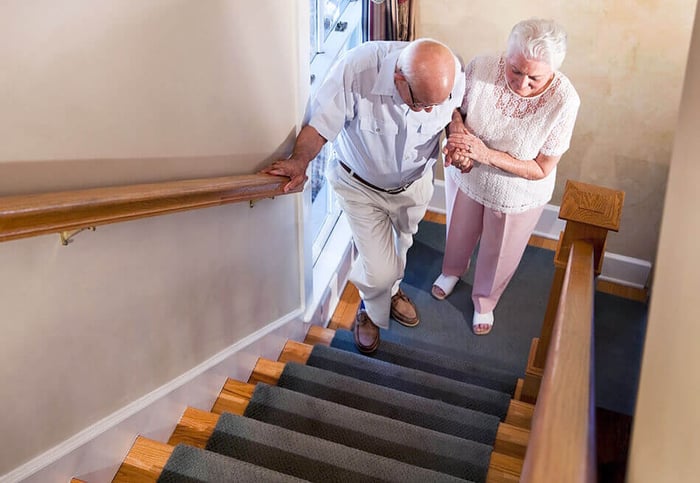As individuals age, the risk of falling becomes an increasingly significant concern. Falls, especially among older adults, can have severe consequences, impacting the victim’s immediate well-being and, quite possibly also, their long-term health. The aftermath of a fall often includes physical injuries, emotional distress, financial burdens, and the potential loss of independence.
According to a Centers for Disease Control and Prevention report, in the United States alone, falls among older adults result in over 3 million emergency department visits annually, with treatment costs exceeding $50 billion. Falls are also the leading cause of fatal and non-fatal injuries among seniors, making it a pressing public health concern.
The consequences of falling extend beyond physical injuries. Older adults who experience a fall may develop a fear of falling again, leading to self-imposed activity limitations and social isolation. This, in turn, can contribute to a decline in physical and mental health.
Additionally, falls can have long-term health implications. Fractures, particularly hip fractures, can significantly impact an individual's mobility and independence, potentially leading to a need for long-term care or assisted living arrangements.
In light of these sobering statistics and potential consequences, caregivers must prioritize home safety for seniors. By implementing preventive measures and creating a safe living environment, caregivers can play a proactive role in minimizing fall risks and promoting the well-being of their loved ones.
Identifying and Managing Fall Risks
Identifying and managing fall risks is the first step in creating a safe environment for seniors. Several factors contribute to an increased risk of falling among older adults. By understanding these factors, caregivers can implement targeted measures to mitigate the risks.
Physical factors such as muscle weakness, impaired balance and gait, reduced vision, and chronic health conditions like arthritis or Parkinson's disease can affect stability and increase the likelihood of falls. Environmental hazards, including slippery floors, poor lighting, uneven surfaces, and clutter, can pose significant risks. Medications with side effects like dizziness or drowsiness can also contribute to falls. Chronic diseases such as osteoporosis, diabetes, cardiovascular conditions, and neurological disorders can weaken the body, impair balance, or affect cognitive function.
Psychological factors, such as fear of falling, anxiety, depression, or cognitive impairments, can impact mobility and increase fall risks. Understanding these factors allows caregivers to tailor interventions accordingly, such as exercise programs to improve strength and balance, vision checks, medication reviews, home modifications, and psychological support.
Creating a Safe Living Space
Since the average person spends up to two-thirds of their life at home, making it a safe living space is a good start to preventing falls. The most important considerations include taking steps to reduce fall hazards, improving lighting to enhance visibility and reduce tripping hazards, and installing grab bars and handrails strategically.
Reduce fall hazards by removing potential obstacles and hazards, clearing clutter, securing loose rugs or carpets, and maintaining clear pathways. Rearranging frequently used items for easy access and organizing storage spaces can also reduce the risk of falls.
Improving lighting allows seniors to see clearly and navigate their surroundings safely. Brighter light bulbs, task lighting for detailed work areas, and nightlights in hallways and bathrooms can enhance visibility. Try to minimize glare and shadows, especially on staircases. Check and replace faulty light fixtures or bulbs to maintain optimal lighting conditions.
Install grab bars and handrails to provide stability and support. Use sturdy bars that can bear weight and place them near toilets, showers, and staircases. Such devices can significantly improve home safety and reduce fall risks but you must ensure that they are securely mounted with studs or wall anchors.
Using Mobility Aids
Mobility aids significantly enhance the safety and independence of seniors with mobility challenges. They serve to provide stability, support, and assistance in walking or maintaining balance. They help individuals with various mobility limitations to regain confidence and engage in daily activities. Let’s take a closer look at the options.
Canes are lightweight and versatile mobility aids that provide support and improve balance. They are suitable for individuals with mild balance issues or those who require minimal assistance. Canes come in various designs, such as single-point canes and quad canes, offering different levels of stability. However, canes may not be appropriate for those with significant mobility limitations or upper body weakness.
Walkers offer increased stability and support, making them suitable for individuals with moderate to severe mobility challenges. Standard walkers provide four-legged support, while wheeled walkers offer greater maneuverability. However, walkers tend to be bulkier and less convenient for navigating tight spaces or stairs.
Wheelchairs and power scooters are suitable for individuals with severe mobility limitations or those who are unable to walk independently. Wheelchairs offer complete mobility support, while power scooters provide powered assistance for longer distances. These devices are best suited for individuals with limited or no weight-bearing capacity and may require assistance from caregivers.
When selecting a mobility aid, it is essential to consider the individual's specific needs, physical abilities, and limitations. To get help in determining the most suitable mobility aid, contact the team at LL Medico. We have over 25 years of experience in a range of mobility aids. We can also advise on incontinence products and other senior care requirements.
Staying Active
Exercise plays a key role in enhancing strength, balance, and flexibility for seniors. Regular physical activity helps maintain muscle tone, improve joint mobility, and reduce the risk of falls. Exercise programs designed specifically for seniors focus on enhancing cardiovascular health, strength training, and balance exercises like tai chi or yoga.
Physical therapy can provide personalized guidance, addressing individual needs and challenges. By incorporating regular exercise and physical therapy into their routines, seniors can improve their overall physical capabilities, boost confidence, and reduce the risk of falls, ultimately promoting independence and a higher quality of life.
Managing Medication Side Effects
Many medications have side effects such as dizziness, drowsiness, or impaired balance which can all increase the risk of falls. Patients and caregivers must communicate with healthcare providers to understand the risks associated with each medication.
In the event that side effects are identified, healthcare professionals usually offer alternative options or adjust dosages. By staying informed, caregivers can play a key role in ensuring that seniors' medication regimens are optimized for safety, reducing the likelihood of falls and promoting overall well-being.
Coping with Fear of Falling
The steps taken to reduce fall risks, such as improving home safety, using mobility aids, staying active, and managing medications, contribute to building confidence and overcoming anxiety. By implementing these strategies, seniors can regain a sense of control and trust in their abilities, knowing that they have taken proactive measures to reduce fall risks.
Additionally, engaging in regular physical activity, participating in fall prevention programs, and seeking support from healthcare professionals, support groups or experienced product retailers like LL Medico can provide valuable resources and reassurance. Overcoming the fear of falling allows seniors to embrace life with confidence, maintaining their overall well-being and enjoying a higher quality of life.







 855-422-4556
855-422-4556 Chat
Chat E-Mail
E-Mail Monday - Friday 9:00AM to 5:00PM EST
Monday - Friday 9:00AM to 5:00PM EST





 Shopping With LL Medico
Shopping With LL Medico
 855-422-4556
855-422-4556